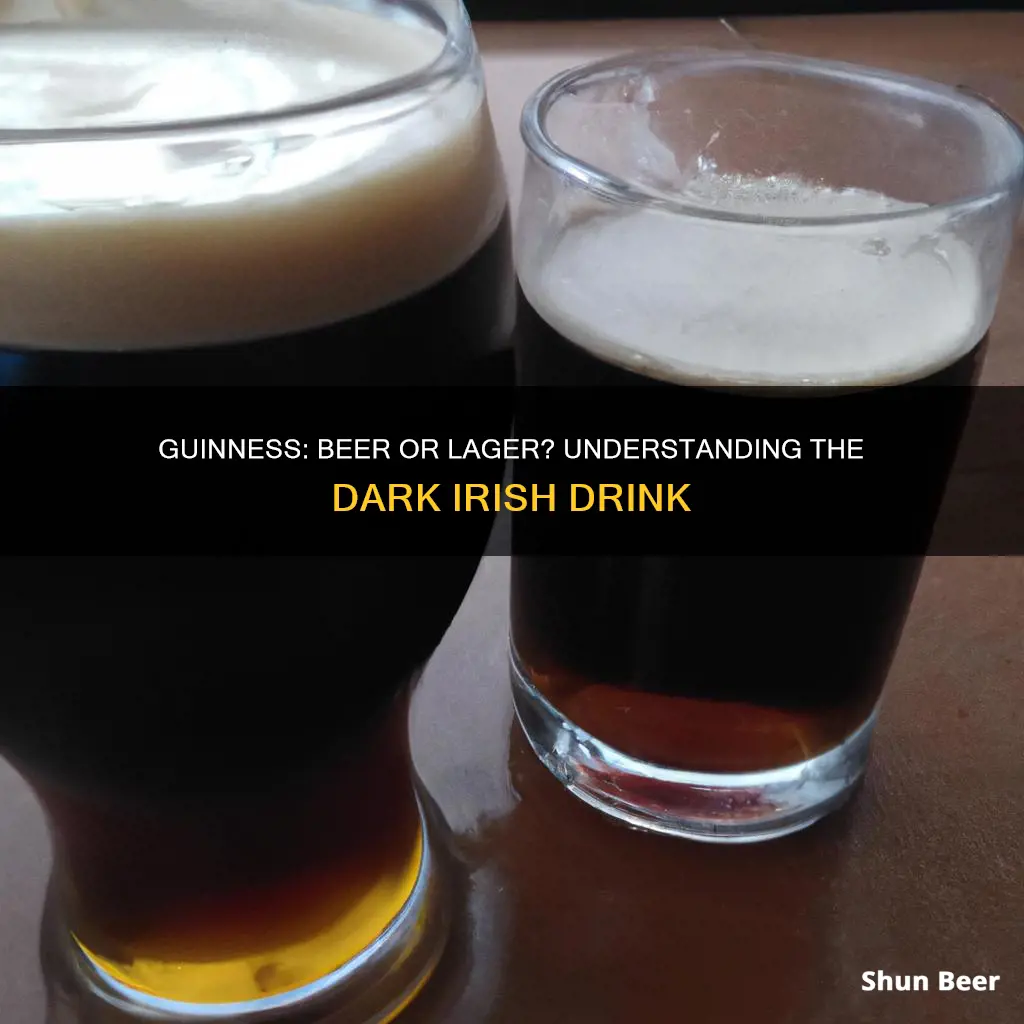
Guinness is a traditional Irish stout beer, first produced in Dublin, Ireland, at the brewery of Arthur Guinness in 1759. It is one of the most successful beer brands worldwide, brewed in almost 50 countries and available in over 120. The beer is made from barley, hops, water, and a specific strain of ale yeast. The deep colour and caramelised flavour that are characteristic of Guinness come from barley that has been roasted but not malted. The dark ale is known for its dense, creamy head, which is achieved by mixing the beer with nitrogen to create smaller bubbles that result in a thicker head.
While Guinness is primarily known for its stout, the company has also produced a variety of other beers, including a black lager, an American amber lager called Guinness Blonde, and a non-alcoholic beverage called Guinness Zero ABV.
| Characteristics | Values |
|---|---|
| Type of Beer | Stout |
| Place of Origin | Dublin, Ireland |
| Main Ingredients | Barley, hops, water, yeast |
| Colour | Black |
| Flavour | Caramelized |
| Mouthfeel | Dense, creamy |
| Calories | 125 per pint |
| Alcohol by Volume (ABV) | 4.1% to 4.3% |
| Serving Temperature | 6-7 °C |
What You'll Learn

Guinness is a stout, not a lager
Lager is brewed at a cool temperature using bottom-fermenting yeast. Ales, on the other hand, are typically "warm fermented" using top-fermenting yeast that works at higher temperatures. Guinness, being a stout, is an ale.
Lager is brewed at colder temperatures than ale. Lager yeast is generally fermented colder and is what is known as "bottom fermenting" yeast. The cold temperatures usually mean that the profile is very clean. Ales are produced in a warmer environment and can be enjoyed in as little as 2-3 weeks, whereas the brewing process for lager can take multiple weeks or even months.
Stouts have a very high dark malt content, which gives them their distinctive dark colour, while lagers tend to be lighter. Stouts are top-fermented at 18-20°C, while lagers are fermented at the bottom at around 0-2°C. Stouts have a more bitter and intense, ‘hoppier’ flavour compared to lagers.
Breast Milk and Guinness Beer: Any Connection?
You may want to see also

Guinness does produce a black lager, but this is not the widely known version
Guinness is a stout that originated in Dublin, Ireland, in the 18th century. It is one of the most successful alcohol brands worldwide, brewed in almost 50 countries and available in over 120. It is now owned by the British-based multinational alcoholic beverage maker Diageo.
Guinness's flavour derives from malted barley and roasted unmalted barley. The unmalted barley is a relatively modern addition that became part of the grist in the mid-20th century. The draught beer's thick, creamy head comes from mixing the beer with nitrogen and carbon dioxide.
The standard Guinness is a stout, which is a type of ale. However, Guinness does produce a black lager. This was released in 2010 and is known as Guinness Black Lager. It is a variation on the classic Guinness stout, with a less robust flavour and a more watery mouthfeel.
Guinness Black Lager is not widely known, and when someone orders a Guinness in a bar, they are expecting the standard Guinness stout. This is reflected in the fact that the standard Guinness stout is available in many more countries than the black lager.
Guinness Beer's Carb Content: A Detailed Breakdown
You may want to see also

Guinness is an ale, not a lager
Guinness is a stout that originated in the 18th century at the brewery of Arthur Guinness in Dublin, Ireland. It is now owned by the British-based multinational alcoholic beverage maker Diageo and is one of the most successful alcohol brands worldwide.
Despite Guinness producing a black lager, the standard, widely-known Guinness is a stout. A stout is not a lager. Lager yeast is generally fermented colder and is "bottom fermenting", meaning it sinks to the bottom. Ales, on the other hand, ferment warmer and are "top fermenting", meaning the yeast rises to the top.
Guinness is made from water, barley, hops, roast malt extract, and brewer's yeast. A portion of the barley is roasted to give Guinness its dark colour and characteristic taste. The yeast used has been used for over 125 years and is now often referred to as "Guinness yeast".
Guinness is best served cold in a pint glass and is both an excellent pairing for hearty meals and a common ingredient in food and drink recipes.
Guinness Beer: Perfect Pairing Ideas for a Hearty Pint
You may want to see also

Guinness is a top-fermenting yeast
Guinness is a stout, which is a type of beer. It is not a lager. Lager and ale are the two main types of beer, and the distinction between them is based on the type of yeast used in the fermentation process. Lager yeasts are bottom-fermenting, while ale yeasts are top-fermenting. Guinness is a top-fermenting beer, which means that the yeast rises to the top of the fermenter during fermentation. This type of yeast creates a thick, yeast head at the top of the carboy in the early stages of fermentation.
Ale yeasts, such as the type used in Guinness, ferment at warmer temperatures than lager yeasts. Ale yeasts typically ferment at temperatures between 10°C and 25°C, with an ideal range of 18°C to 22°C. Lager yeasts, on the other hand, ferment at colder temperatures, usually between 7°C and 15°C.
The choice of yeast also affects the flavour of the beer. Ale yeasts tend to impart more character to the beer than lager yeasts, which are known for producing a "cleaner" taste. Guinness has a distinctive flavour that comes from malted barley and roasted unmalted barley. The beer also has a sharp lactic acid flavour, which is created by blending aged brew with freshly brewed beer.
Guinness originated in the 18th century at the brewery of Arthur Guinness in Dublin, Ireland. It is now brewed in almost 50 countries and is available in over 120. Guinness is one of the most successful alcohol brands worldwide and is the best-selling alcoholic drink in Ireland.
The Brewing Process: Guinness Beer Filtration Techniques
You may want to see also

Guinness is suitable for vegans
Guinness is a stout, a category of beer known for its rich dark colour and creamy head. It is one of the most successful alcohol brands worldwide, brewed in almost 50 countries and available in over 120.
Guinness is, in fact, suitable for vegans. In 2017, the company introduced a new filtration process that avoided the use of isinglass, a collagen product made from fish bladders, which was previously used to filter out yeast particles. This means that Guinness Draught, Guinness Extra Stout, and Guinness Foreign Extra Stout are all suitable for vegans. Guinness's alcohol-free beer, Guinness 0.0, is also vegan-friendly.
The recipe for Guinness has not changed, and vegans can rest assured that the taste remains the same. The only difference is that the ingredients are now suitable for those on a plant-based diet.
Guinness is made from four main ingredients: roasted and malted barley, hops, water, and yeast. The creamy white head is formed when the beer is poured, causing bubbles of nitrogen and carbon dioxide gas to surge and create the distinctive frothy topping.
So, vegans can enjoy a pint of Guinness without compromising their dietary choices!
Guinness Beer: Iron-Rich Brew or Just a Myth?
You may want to see also







